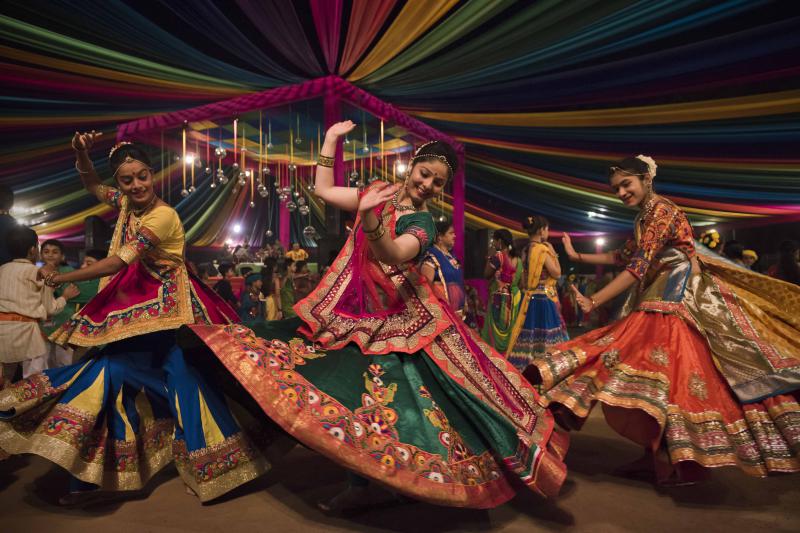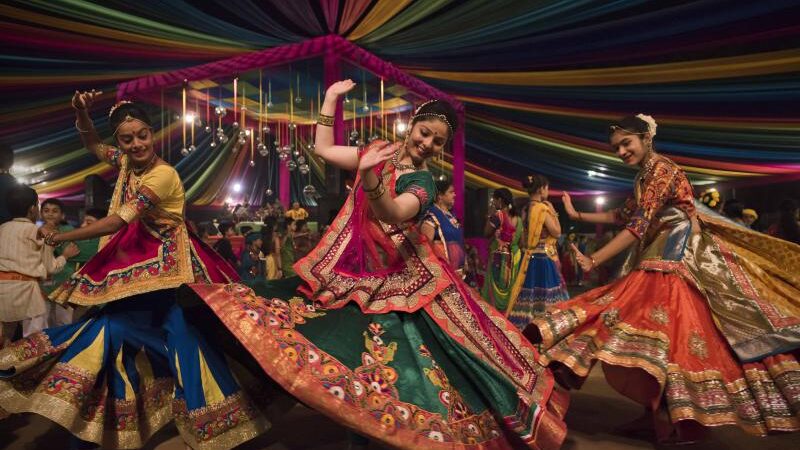 Garba, an exuberant and rhythmic folk dance form, is integral to Indian culture and tradition. Originating from the western state of Gujarat, Garba holds immense significance during the Navratri festival, a nine-night celebration dedicated to the Hindu goddess Durga. This vibrant dance form is characterized by its fast-paced footwork, circular movements, and vibrant costumes. Explore the Garba dance’s history, significance, and various elements, shedding light on its cultural importance and the joyous spirit it brings to communities.
Garba, an exuberant and rhythmic folk dance form, is integral to Indian culture and tradition. Originating from the western state of Gujarat, Garba holds immense significance during the Navratri festival, a nine-night celebration dedicated to the Hindu goddess Durga. This vibrant dance form is characterized by its fast-paced footwork, circular movements, and vibrant costumes. Explore the Garba dance’s history, significance, and various elements, shedding light on its cultural importance and the joyous spirit it brings to communities.
The roots of the Garba dance can be traced back to ancient times. The term “Garba” is derived from the Sanskrit word “Garbha,” meaning womb. It symbolizes the nurturing aspects of motherhood and the cycle of life. Garba originates in the folklore associated with the Hindu goddess Amba, also known as Durga or Shakti. It is believed that the dance form originated as a form of worship and celebration of the goddess during the festival of Navratri. Over time, Garba evolved into a social dance performed by men and women in communities across Gujarat.
The dance is performed around a central pole or statue of the goddess Durga and is said to represent the movement of the planets around the sun. Garba is typically performed in a circle, with the dancers moving clockwise and counterclockwise around the central pole. The dance is often accompanied by traditional Indian music, and the dancers wear traditional Indian clothing. There are many different steps and movements involved in Garba, and the dance can be performed either solo or in a group. Garba is a very popular dance form in India and is often performed at weddings and other special occasions.
Garba is a lively and energetic dance form characterized by its distinctive elements, such as costumes, music, instrument, and footwork. The details are listed below.
- Costumes: The attire worn during Garba is integral to the dance. Women traditionally wear a chaniya choli, a three-piece ensemble with a flared skirt, blouse, and dupatta (scarf). The chaniya choli is adorned with intricate embroidery, mirror work, and vibrant colors. Men usually wear a kediyu, a colorful top, and dhoti pants. The costumes add visual splendor to the dance, enhancing the festive atmosphere.
- Music and Instruments: Garba music, known as “Garba Raas,” is an essential dance component. It features a distinct rhythm and beat, often accompanied by traditional instruments such as dhol (drums), nagada (kettle drums), and harmonium (a small keyboard instrument). The melodies are usually derived from traditional folk songs or devotional hymns, creating a lively and energetic ambiance.
- Footwork and Movements: Garba is known for its intricate footwork and graceful movements. The dancers move in circular patterns, stepping rhythmically in sync with the music. The dance involves twirling, clapping, and hand gestures, creating a captivating visual spectacle. The footwork requires agility, coordination, and precision, making Garba a challenging dance form to master.
 Garba dance holds immense cultural significance and is cherished as a symbol of community bonding, joy, and devotion. It serves as a medium to celebrate and showcase Gujarat’s rich heritage and traditions. Here are some key aspects of Garba’s cultural importance:
Garba dance holds immense cultural significance and is cherished as a symbol of community bonding, joy, and devotion. It serves as a medium to celebrate and showcase Gujarat’s rich heritage and traditions. Here are some key aspects of Garba’s cultural importance:
- Social Cohesion: Garba brings people together, fostering a sense of unity and belonging. It transcends age, gender, and social barriers, as individuals from all walks of life participate in the dance. Communities come together during Navratri, strengthening social bonds and creating a shared sense of celebration.
- Preservation of Folklore: Garba is deeply rooted in Gujarati folklore and mythology. This dance form passes cultural stories, legends, and traditions from generation to generation. Garba serves as a platform for preserving and promoting Gujarat’s cultural heritage, ensuring its continuity and relevance.
- Festive Spirit: Navratri and Garba radiate a festive spirit that engulfs Gujarat during the nine-night extravaganza. The vibrant costumes, foot-tapping music, and infectious enthusiasm create an atmosphere of joy and celebration. Garba catalyzes happiness, allowing people to break free from their daily routines and immerse themselves in festive fervor.
Garba dance is not just a dance form; it embodies culture, tradition, and spirituality. Originating from Gujarat, it has transcended regional boundaries and become a global phenomenon, captivating audiences with its vibrant energy and rich heritage. The dance’s historical roots, association with the Navratri festival, and cultural significance make Garba a cherished tradition in Indian society. As communities come together to perform this rhythmic dance, Garba continues to spread joy, foster unity, and keep alive the vibrant traditions of Gujarat for generations to come.



